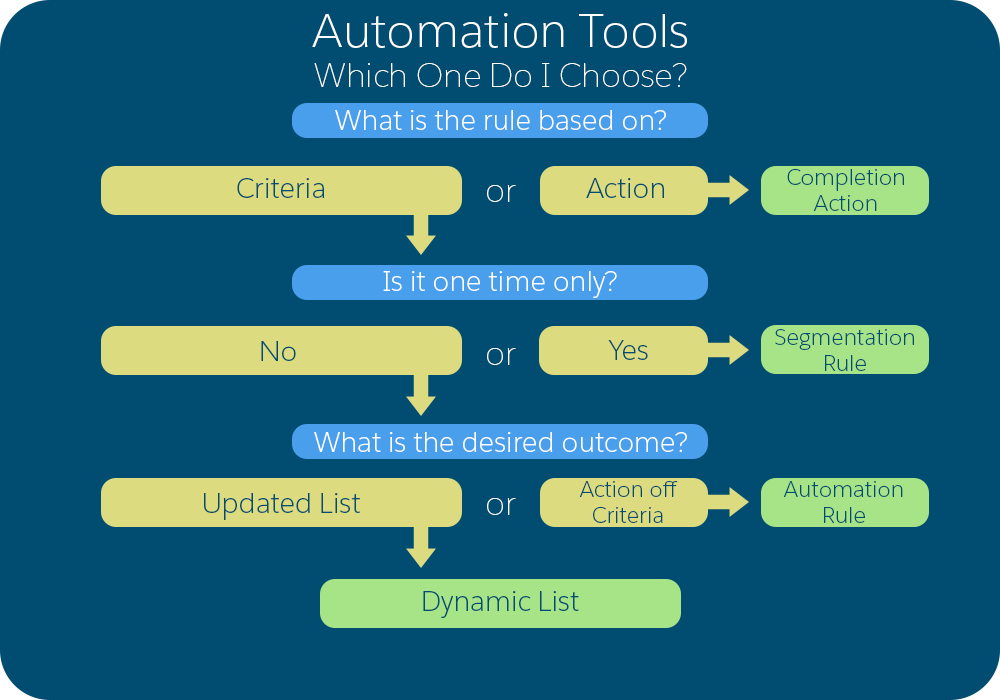Pardot, newly renamed as Marketing Cloud Account Engagement, is a B2B marketing automation platform. In this post, we will see how to lay the groundwork for Pardot implementation. (For the benefit of comprehension, we shall stick to the old name in this post.)
Incidentally, we are certified Pardot experts ourselves. From building responsive Pardot newsletter templates to setting up Pardot automation to campaign management to seamless migration, we have helped inter-industrial businesses across the globe.
1. Identify the Pardot Cadre
Pardot implementation is not a one-man job. So, your first step would be to identify the right people who can help you with the setup. This will involve experts from the IT team, including liaison with website and email admins.
2. Draw up A Journey Map
Without a coherent journey map, Pardot is just a directionless mess of features and functionalities. Having a journey map is important as it helps you prioritize your most important business objectives and clarifies the most optimal means to achieve them.
Business models, company size, marketing goals, data scope, and availability of in-house resources all play a decisive role in Pardot implementation.
3. Pardot Technical Setup
The technical setup in Pardot involves three preliminary steps, starting with tracking code implementation, then adding a tracker domain, and finally, DKIM authentication. Let’s look at each one separately:
- Tracking code implementation: Each Pardot campaign has a unique tracking code. Add the code to the webpage in order to track visitors and identify prospects.
- Add a tracker domain: A tracker domain allows you to conceal your Pardot-hosted assets with a custom URL. You can replace ‘Pardot’ in the URL with your brand name.
- Implement DKIM authentication: DKIM authentication ensures that emails are sent from legitimate sources. It is also important for legal compliance and building credibility.
Note that all business units created after February 13, 2023, use first-party tracking.
4. Add Users to Pardot
The next step is to put the right people at the controls. First, your Salesforce admin should assign users to Pardot. As per Salesforce’s own recommendation, the admin should “assign users who manage the implementation.”
That done, Salesforce will take over user management, following which you return to Marketing Setup and assign more users as required.
Note that users will have no access until you set up permissions for the Pardot Lightning app. In Pardot Lightning, the Sales Users group in Salesforce will take up the Sales role. If you want to change a user’s role, it must be done in Salesforce.
5. SF-Pardot Integration
It is recommended that you integrate Salesforce and Pardot. It will save time, minimize clutter, and you can also avail cross-product features. Generally speaking, it is helpful when the sales and marketing teams are aligned.
You will need to use Salesforce Pardot connectors to implement the integration. Now, there are two kinds of connectors: v1 and v2. The predominant role of these connectors is to facilitate seamless data syncing between Salesforce and Pardot.
Integration also allows you to generate highly qualified leads, implement data-driven marketing strategies, utilize advanced tracking capabilities, and work with prebuilt templates for forms, emails, and landing pages.
6. Salesforce Engage Setup
The value of Salesforce Engage, now known as Sales Emails and Alerts, lies in its ability to use marketing assets to maximize the selling power of your brand. A few things to note:
- You cannot set up Salesforce Engage without first implementing a Salesforce connector.
- You cannot use Salesforce Engage for Salesforce sandboxes.
- Do not add legacy Custom Permissions for Pardot to your Salesforce profile.
- Make sure you have the necessary API permissions or Engage will not function properly.
Learn more about Salesforce Engage Setup here.
7. Marketing Analytics Setup
Marketing analytics helps you gain a unified view of your customers, valuable optimization insights, and a measurable impact of your campaigns. Salesforce allows you to set up B2B marketing analytics. Just follow these steps:
- Go to Marketing Setup, select B2B Marketing Analytics, and click Getting started.
- For sharing marketing data, click Manage Assignments and add the Integration user. Then, add the users who need access to B2B Marketing Analytics apps.
To enable CRM analytics, just click Open CRM Analytics Setup, and enable it. Lastly, to enable data sync and connections, click Open CRM Analytics Setup again, select Enable Data Sync and Connections, and save the update.
- Schedule Data Sync. That done, after settings and permissions are set up, you can access Analytics Studio.
Next, we look at the creation of marketing assets in Pardot.
8. Create Marketing Assets
Pardot allows you to create four kinds of marketing assets: landing pages, email templates, forms, and email preference centers.
- Landing page: The Landing Page builder is a drag-and-drop tool in the Salesforce Lightning App. From list views to actions to reporting, it offers a range of functionalities.
- Lead-capturing forms: You can build forms to capture visitor information and leads in all Pardot editions. You can design and manage hosted forms, channel external data into Pardot via form handlers, and embed forms in landing pages.
- Email templates: Pardot offers you a wide range of prebuilt email templates. You can also customize templates to suit your unique business needs.
- Email preference center: Pardot allows you to create email preference pages to help your audience manage their email subscriptions. You can also add a custom email preference center to an email. It is available in all Pardot editions.
Note that you can use both default and custom email preference center pages in Pardot.
9. Hosting Files Setup
File hosting refers to the storage of your files, including images, videos, javascript, CSS, etc. in Pardot. In this way, Pardot ‘hosts’ your marketing resources.
File hosting is recommended as it secures your files against unauthorized access. You can monitor the performance of these files via Pardot analytics. Because all your marketing resources will be within the Pardot environment, you can create dynamic content using these files and also establish consistent branding across all marketing channels.
Note that there are a few things to keep in mind when you host files on Pardot. You can view the full list of criteria here.
10. Pardot Segmentation
You can create segments on Pardot in four different ways: lists, rules, tags, and profiles.
There are two kinds of lists: static and dynamic. A static list consists of leads that are built and edited manually, whereas a dynamic list updates automatically upon changes in prospect data.
Dynamic lists operate according to rules. You set up a list of criteria, such as grades, field values, activity scores, etc., and the list updates on the basis of these criteria.
Tags are basically labels to categorize your prospects based on predefined criteria. These, again, can be manual or automated.
Lastly, profiles allow you to segment prospects according to their geographical and demographic attributes.
11. Automation Tools Setup
Pardot offers four kinds of automation tools to speed up and streamline mundane marketing tasks: completion actions, segmentation rules, page actions, and automation rules.
Completion actions trigger relevant predefined responses whenever a user interacts with forms, emails, files, custom redirects, etc.
With the help of segmentation rules, you can create a list of prospects and enforce a segmentation action on the basis of specific criteria. When you run a rule, it matches only those prospects that meet the criteria for that rule.
Automation rules, unlike segmentation rules, can be run more than once. They are criteria-dependent. The rules find matching prospects and apply the relevant actions to them.
Now, it’s important to determine which automation tools are right for you. Ask yourself if the rule is criteria-based or action-based, if you are looking for one-time automation, and the goal of using automation.

12. Integrate And Test
You are done establishing the groundwork. Now, it’s time to integrate Pardot with your preferred platform and test the implementation.
Pardot can be integrated with a number of platforms, including Google Ads, Google Analytics, Slack, etc., via Salesforce Connector, Microservice, and Pardot API. Once you are done testing the implementation, you are ready to deploy Pardot.
Wrapping Up!
Laying the groundwork for successful Pardot implementation might seem complex at first. But Pardot is among the most intuitive marketing automation tools out there. Once you incorporate the internal logic of the system, from team setup to testing, it ultimately almost self-aligns with your unique vision as a marketer.
Still, if you are not sure, we are certified Marketing Cloud experts. Feel free to hit us up!




Mrugesh Dabhi
Latest posts by Mrugesh Dabhi (see all)
Notch Up More Conversions by Leveraging These Email Marketing Automation Trends in 2024!
60 Most Effective Father’s Day Email Subject Lines